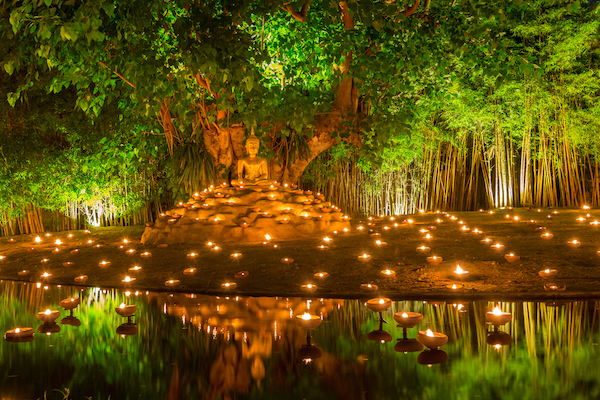
Martin Goodson
What is Rohatsu?
Exercises in Mindfulness
The memorial to the Buddha's Enlightenment is a week long Zen retreat that tests the monastic's inner strength to the full.

Buddha under Bodhi Tree Wesak Day
shutterstock
There are three main commemorative events in the Buddhist calendar which centre on three events in the Buddha's life - his birth, his enlightenment and his death.
In the Southern tradition of Buddhism, all three are celebrated at Wesak, which takes place at the full moon in May. In the North-Eastern traditions, these events take place at different times of the year. It may well be that the Southern tradition, being equatorial does not have the differences in seasonal light and dark days that the more Northerly traditions experience. In the same way as festivals of light are common during the winter months, especially around the winter solstice, so the Zen schools, part of that North-Eastern tradition, place the Buddha's Enlightenment on 8th December.
In Zen temples and monasteries around the world, the week leading up to the 8th December is one of the most difficult sesshins (Zen retreat) in the monastic calendar. Prior to the start of the sesshin on 1st December, the monastery receives a thorough clean, supplies for the week are taken in and all work, bathing and leave is stopped for the period. On 1st December the gates are closed and will not be opened until the morning of 8th day.
The timetable is gruelling with mainly sitting meditation (Zazen) and with only a couple of hour’s opportunity for sleep. The general rule is that lying down is avoided and 'sleep', such as it is, has to take place on the cushion during the night when for a few hours the Zazen is not being invigilated.
The start also generally coincides with the first cold snap of winter. There is no central heating and the walls and floors are made of wood so provide little protection from the elements. Even seasoned monks feel apprehension as the time for Rohatsu approaches.
In Japan, lay people can join in with local temples who have Zazen groups as part of their pastoral care. And many do.
Some lay groups will sit through one night as an extra effort to recall the extraordinary effort made by the ascetic Gautama, who sat under the Bodhi Tree in one final effort to awaken to the truth. This the Buddha did on the morning of the eighth day as he looked up into the clear dawn sky and saw the morning star.
Such events, which are part of the Buddhist calendar, tie us into the lineage with all those who came before us. The extra efforts we make during this time are shared by everyone else who is also making such an effort and this helps deepen our own practice and evokes gratitude for all those who came before us who have kept this path open for us. After all, if only the Buddha had walked this way, then the path would very quickly have become overgrown and have been forgotten.
So, for those who would like to make an extra effort, make a note in your diary and think of how you might like to join in with this commemorative event. Some ideas for a Rohatsu extra effort might include:
Sitting Zazen every day for the week, or if you already do this then sit a little longer.
Dedicate one day during the week to have a 'quiet' day where you can retreat at home (if the situation allows for it), with several periods of sitting throughout, with no speaking, no TV, social media, no reading except one period of a suitable Buddhist text.
Hold a morning service before setting out for the day to include - some chanting (see The Zen Gateway's audio course for how to do this and to download the text of the two most popular chants). If you have a home shrine with either a Buddha statue (rupa) or a picture of the Buddha then you might like to light a candle and some incense and make sure that there are some fresh flowers nearby as offerings as a sign of gratitude.
Since it is said that the Buddha sat both night and day, if you can arrange your diary to suit, then you might like to sit one night through. However, this is only if you are comfortable sitting Zazen for 60 minutes or in 90- minute blocks (in three equal periods with short breaks between to relax posture and stretch). Blocks of sitting should be interspersed with half hour walks and some breaks with tea and biscuits.
A timetable for a night-sitting might be as follows:
2000hrs Chanting the Heart Sutra and Four Bodhisattva Vows
2010hrs Zazen
2040hrs Audio talk from The Zen Gateway for 30-40 minutes
2110hrs Tea break
2130hrs Zazen
2300hrs Informal walking
2330hrs Zazen
0100hrs Tea break
0130 Zazen
0300 Chanting the Heart Sutra and the Four Bodhisattva Vows
END
Whatever you decide to do - have a good Rohatsu and see you on the other side!




